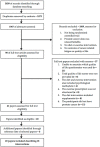The Effect of Nutrition Therapy and Exercise on Cancer-Related Fatigue and Quality of Life in Men with Prostate Cancer: A Systematic Review
- PMID: 28895922
- PMCID: PMC5622763
- DOI: 10.3390/nu9091003
The Effect of Nutrition Therapy and Exercise on Cancer-Related Fatigue and Quality of Life in Men with Prostate Cancer: A Systematic Review
Abstract
Background: Improvements in diet and/or exercise are often advocated during prostate cancer treatment, yet the efficacy of, and optimal nutrition and exercise prescription for managing cancer-related fatigue and quality of life remains elusive. The aim of this study is to systematically review the effects of nutrition and/or exercise on cancer-related fatigue and/or quality of life.
Methods: A literature search was conducted in six electronic databases. The Delphi quality assessment list was used to evaluate the methodological quality of the literature. The study characteristics and results were summarized in accordance with the review's Population, Intervention, Control, Outcome (PICO) criteria.
Results: A total of 20 articles (one diet only, two combined diet and exercise, and seventeen exercise only studies) were included in the review. Soy supplementation improved quality of life, but resulted in several adverse effects. Prescribing healthy eating guidelines with combined resistance training and aerobic exercise improved cancer-related fatigue, yet its effect on quality of life was inconclusive. Combined resistance training with aerobic exercise showed improvements in cancer-related fatigue and quality of life. In isolation, resistance training appears to be more effective in improving cancer-related fatigue and quality of life than aerobic exercise. Studies that utilised an exercise professional to supervise the exercise sessions were more likely to report improvements in both cancer-related fatigue and quality of life than those prescribing unsupervised or partially supervised sessions. Neither exercise frequency nor duration appeared to influence cancer-related fatigue or quality of life, with further research required to explore the potential dose-response effect of exercise intensity.
Conclusion: Supervised moderate-hard resistance training with or without moderate-vigorous aerobic exercise appears to improve cancer-related fatigue and quality of life. Targeted physiological pathways suggest dietary intervention may alleviate cancer-related fatigue and improve quality of life, however the efficacy of nutrition management with or without exercise prescription requires further exploration.
Keywords: cancer-related fatigue; exercise; nutrition; prostate cancer; quality of life.
Conflict of interest statement
The authors declare no conflict of interest.
Figures







References
-
- Australian Institute of Health and Welfare Cancer in Australia: Actual incidence and mortality data from 1982 to 2007 and projections to 2010. Asia-Pac. J. Clin. Oncol. 2011;7:325–338. - PubMed
-
- Australian Institute of Health and Welfare Cancer in Australia: Actual incidence data from 1991 to 2009 and mortality data from 1991 to 2010 with projections to 2012. Asia-Pac. J. Clin. Oncol. 2013;9:199–213. - PubMed
-
- Australian Institute of Health and Welfare Cancer survival and prevalence in Australia: Period estimates from 1982 to 2010. Asia-Pac. J. Clin. Oncol. 2013;9:29–39. - PubMed
-
- World Cancer Research Fund International . Diet, Nutrition, Physical Activity, and Prostate Cancer. American Institute for Cancer Research; Arlington, VA, USA: 2014.
-
- Australian Institute of Health and Welfare . Australian Cancer Incidence and Mortality (ACIM): Prostate Cancer. AIHW; Canberra, Australia: 2016.
Publication types
MeSH terms
LinkOut - more resources
Full Text Sources
Other Literature Sources
Medical

